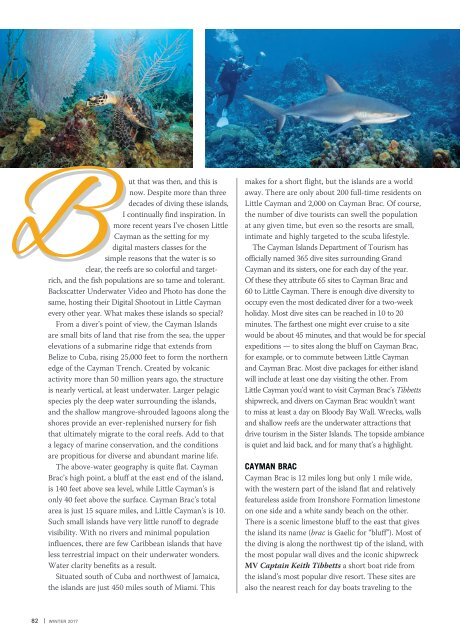AD 2017 Q1
Alert Diver is the dive industry’s leading publication. Featuring DAN’s core content of dive safety, research, education and medical information, each issue is a must-read reference, archived and shared by passionate scuba enthusiasts. In addition, Alert Diver showcases fascinating dive destinations and marine environmental topics through images from the world’s greatest underwater photographers and stories from the most experienced and eloquent dive journalists in the business.
Alert Diver is the dive industry’s leading publication. Featuring DAN’s core content of dive safety, research, education and medical information, each issue is a must-read reference, archived and shared by passionate scuba enthusiasts. In addition, Alert Diver showcases fascinating dive destinations and marine environmental topics through images from the world’s greatest underwater photographers and stories from the most experienced and eloquent dive journalists in the business.
Create successful ePaper yourself
Turn your PDF publications into a flip-book with our unique Google optimized e-Paper software.
ut that was then, and this is<br />
now. Despite more than three<br />
decades of diving these islands,<br />
I continually find inspiration. In<br />
more recent years I’ve chosen Little<br />
Cayman as the setting for my<br />
digital masters classes for the<br />
simple reasons that the water is so<br />
clear, the reefs are so colorful and targetrich,<br />
and the fish populations are so tame and tolerant.<br />
Backscatter Underwater Video and Photo has done the<br />
same, hosting their Digital Shootout in Little Cayman<br />
every other year. What makes these islands so special?<br />
From a diver’s point of view, the Cayman Islands<br />
are small bits of land that rise from the sea, the upper<br />
elevations of a submarine ridge that extends from<br />
Belize to Cuba, rising 25,000 feet to form the northern<br />
edge of the Cayman Trench. Created by volcanic<br />
activity more than 50 million years ago, the structure<br />
is nearly vertical, at least underwater. Larger pelagic<br />
species ply the deep water surrounding the islands,<br />
and the shallow mangrove-shrouded lagoons along the<br />
shores provide an ever-replenished nursery for fish<br />
that ultimately migrate to the coral reefs. Add to that<br />
a legacy of marine conservation, and the conditions<br />
are propitious for diverse and abundant marine life.<br />
The above-water geography is quite flat. Cayman<br />
Brac’s high point, a bluff at the east end of the island,<br />
is 140 feet above sea level, while Little Cayman’s is<br />
only 40 feet above the surface. Cayman Brac’s total<br />
area is just 15 square miles, and Little Cayman’s is 10.<br />
Such small islands have very little runoff to degrade<br />
visibility. With no rivers and minimal population<br />
influences, there are few Caribbean islands that have<br />
less terrestrial impact on their underwater wonders.<br />
Water clarity benefits as a result.<br />
Situated south of Cuba and northwest of Jamaica,<br />
the islands are just 450 miles south of Miami. This<br />
makes for a short flight, but the islands are a world<br />
away. There are only about 200 full-time residents on<br />
Little Cayman and 2,000 on Cayman Brac. Of course,<br />
the number of dive tourists can swell the population<br />
at any given time, but even so the resorts are small,<br />
intimate and highly targeted to the scuba lifestyle.<br />
The Cayman Islands Department of Tourism has<br />
officially named 365 dive sites surrounding Grand<br />
Cayman and its sisters, one for each day of the year.<br />
Of these they attribute 65 sites to Cayman Brac and<br />
60 to Little Cayman. There is enough dive diversity to<br />
occupy even the most dedicated diver for a two-week<br />
holiday. Most dive sites can be reached in 10 to 20<br />
minutes. The farthest one might ever cruise to a site<br />
would be about 45 minutes, and that would be for special<br />
expeditions — to sites along the bluff on Cayman Brac,<br />
for example, or to commute between Little Cayman<br />
and Cayman Brac. Most dive packages for either island<br />
will include at least one day visiting the other. From<br />
Little Cayman you’d want to visit Cayman Brac’s Tibbetts<br />
shipwreck, and divers on Cayman Brac wouldn’t want<br />
to miss at least a day on Bloody Bay Wall. Wrecks, walls<br />
and shallow reefs are the underwater attractions that<br />
drive tourism in the Sister Islands. The topside ambiance<br />
is quiet and laid back, and for many that’s a highlight.<br />
CAYMAN BRAC<br />
Cayman Brac is 12 miles long but only 1 mile wide,<br />
with the western part of the island flat and relatively<br />
featureless aside from Ironshore Formation limestone<br />
on one side and a white sandy beach on the other.<br />
There is a scenic limestone bluff to the east that gives<br />
the island its name (brac is Gaelic for “bluff”). Most of<br />
the diving is along the northwest tip of the island, with<br />
the most popular wall dives and the iconic shipwreck<br />
MV Captain Keith Tibbetts a short boat ride from<br />
the island’s most popular dive resort. These sites are<br />
also the nearest reach for day boats traveling to the<br />
82 | WINTER <strong>2017</strong>









